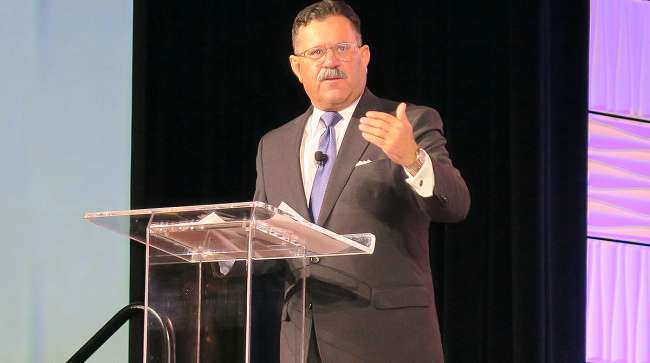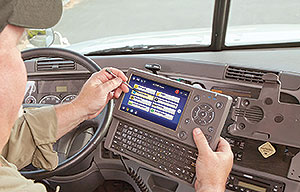Managing Editor, Features and Multimedia
FMCSA’s Ray Martinez Urges Carriers to Convert AOBRDs to ELDs

DALLAS — Ray Martinez, the head of the Federal Motor Carrier Safety Administration, urged carriers to complete the trucking industry’s transition to electronic logging devices and expressed optimism about the potential to add flexibility to driver hours-of-service rules.
Martinez also discussed the agency’s position on automated driving technology for commercial vehicles during a Feb. 25 address here at technology vendor Omnitracs’ annual user conference.
ALSO AT THE CONFERENCE: Omnitracs Aims to Boost Fleet Efficiency by Migrating to ‘Cloud-Native’ Platform
For ELD compliance, the most pressing issue is the upcoming phaseout of older e-log systems classified as automatic onboard recording devices, or AOBRDs, which pre-date the ELD rule.

The AOBRD exemption expires Dec. 16. (Omnitracs)
Although the ELD mandate has been in effect since late 2017, the regulation includes a provision allowing fleets that had installed AOBRDs in their trucks to continue using them for two more years. That exemption is set to expire Dec. 16.
“We are still in a time of transition with ELDs, but 2019 is going to be a critical year as the grandfather provision for the AOBRD sunsets in December,” Martinez said. “I really don’t want anybody to be complacent about this.”
He called for fleets to plan and implement this transition from AOBRDs to ELDs “as soon as you possibly can,” and expressed concern that the bulk of AOBRD users might wait until the final quarter of the year to make the change.
“Please, prepare for this transition if you have not done so already,” he said.
Martinez added that he doesn’t want to see a late push to extend the deadline to migrate from AOBRDs to ELDs.
“I really think that uncertainty is not helpful for anybody,” he said.
From a broader perspective, Martinez acknowledged that the ELD rollout has been “a big transition” for the industry but one that was necessary and mandated by Congress.
FMCSA’s initial data indicate that the regulation already has yielded positive results, he said.
Since the Commercial Vehicle Safety Alliance’s out-of-service criteria went into effect last April, fewer than 1% of all inspections have resulted in the driver being cited for operating without a required ELD or grandfathered AOBRD, Martinez said.
Meanwhile, HOS violations have dropped by 52% over the last year, he said. “These are steps that are in the right direction, and we are committed to seeing better results in 2019.”
At the same time, the growing amount of data collected by ELDs has helped to open the door for FMCSA to examine areas of current HOS regulations “that we may need to adjust or improve,” Martinez said.
FMCSA received more than 5,200 specific public comments on an advance notice of proposed rulemaking to consider ways to provide more flexibility under HOS.
Both the quantity and quality of those comments “were excellent, and really informed the agency,” Martinez said.
While he stopped short of announcing that FMCSA would issue a notice of proposed rulemaking — the next stage of the regulatory process — Martinez did say that he’s “very pleased and very encouraged about the prospects of being able to move forward.”
On a separate note, Martinez discussed the latest efforts by FMCSA and the broader U.S. Department of Transportation to engage with emerging technologies as a way to promote greater safety.
In particular, he focused on the development of driver-assist technology and automated driving systems for commercial trucks.
“I’m really excited about the incremental introduction of these new technologies into vehicles that help the driver, and maybe make it a more attractive career,” Martinez said.
Last year, FMCSA reviewed its existing safety regulations for any inadvertent barriers to the safe testing and deployment of commercial motor vehicles with automated driving systems.

In our season 2 debut episode of RoadSigns, we ask: What will trucking's business leaders need to make the transition from AOBRDs to ELDs in time? Hear a snippet from Fred Fakkema, vice president of compliance at Zonar, above, and get the full program by going to RoadSigns.TTNews.com.
“When it comes to operating ADS-equipped CMVs, we will no longer assume that a CMV driver is always a human, or that a human is necessarily present onboard a commercial motor vehicle during operation,” Martinez said. “That’s pretty dramatic, but when we read through the regulations, there was nothing specific that could not be a system versus a human.”
That doesn’t mean that such a high level of automation is ready today, he said. Instead, the goal is to ensure that the path is clear for innovation.
Even as technology advances, people who enter the trucking industry can still have a full career ahead of them as truck drivers, Martinez said.
“You’re not going to have fully automated vehicles anytime soon that actually have any kind of measurable impact on commerce. That’s my opinion,” he said. “But the technology is going to continue to develop, and the job … of the driver may change gradually over a period of time. And maybe it’ll become easier. Maybe it’ll encourage more people to come into the field.”
Looking ahead, FMCSA is now finalizing an ANPRM to seek input on lingering issues for the adoption and safe implementation of automated-driving systems, such as inspection protocols, human-system interactions and workforce issues, he added.


